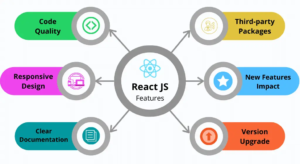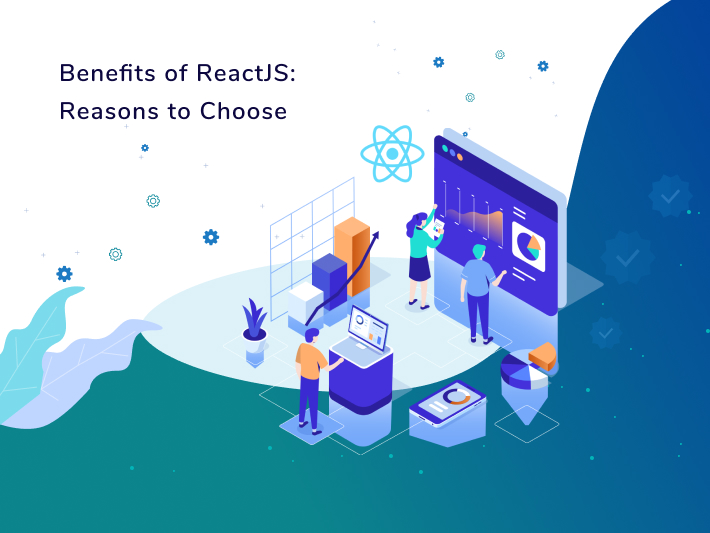React has rapidly become one of the most popular JavaScript libraries for building user interfaces, particularly single-page applications. Developed and maintained by Facebook, React’s declarative, component-based approach has revolutionized front-end development. If you’re considering technologies for your next web project, here are the top 10 benefits of using React.
1. Component-Based Architecture
React’s component-based architecture allows developers to build encapsulated components that manage their own state, and then compose them to make complex UIs. This modular approach makes it easier to manage and maintain the codebase, as each component can be developed, tested, and debugged in isolation.
Benefits:
- Reusability: Components can be reused across different parts of the application, reducing redundancy and effort.
- Maintainability: Simplifies the process of maintaining and updating code, as changes in one component do not affect others.
2. Virtual DOM for Performance
React uses a Virtual DOM to optimize rendering. Instead of directly manipulating the browser’s DOM, React updates a virtual representation of the DOM, which is then compared to the real DOM. Only the differences are updated in the actual DOM, leading to significant performance improvements.
Benefits:
- Efficiency: Reduces the number of costly DOM manipulations, resulting in faster performance.
- Smooth User Experience: Enhances the responsiveness of the application, providing a seamless user experience.
3. Declarative UI
React’s declarative approach to building UIs means that developers describe what the UI should look like, and React takes care of the rendering. This makes the code more predictable and easier to debug.
Benefits:
- Simplicity: Developers focus on the ‘what’ rather than the ‘how’, simplifying the development process.
- Readability: Declarative code is more readable and easier to understand, which aids in collaboration and maintenance.

4. Strong Community and Ecosystem
React boasts a large, active community and a rich ecosystem of tools, libraries, and extensions. Whether you need routing, state management, or form handling, there’s likely a well-maintained library available.
Benefits:
- Support: An active community means plenty of resources, tutorials, and support available.
- Tooling: A vast ecosystem of tools enhances development efficiency and productivity.
5. Cross-Platform Development
With React Native, you can use React to build native mobile applications. This means you can leverage the same skills and codebase to create applications for both web and mobile platforms.
Benefits:
- Cost-Effective: Reduces the need for separate development teams for web and mobile.
- Code Reusability: Significant portions of code can be reused across web and mobile platforms, speeding up development.
6. SEO-Friendly
React can be rendered on the server using server-side rendering (SSR) with frameworks like Next.js. This makes it more SEO-friendly, as search engines can index the content more easily.
Benefits:
- Improved SEO: Enhances the visibility of your web application in search engine results.
- Faster Page Loads: Server-side rendering can improve the initial load time of the page, enhancing the user experience.
7. Flexible and Scalable
React’s flexibility allows it to be used in a variety of projects, from small websites to large enterprise applications. Its component-based architecture also scales well as the application grows.
Benefits:
- Versatility: Suitable for a wide range of projects and use cases.
- Scalability: Can handle growing application complexity and size without significant performance degradation.
8. Strong Backing and Continuous Improvement
React is maintained by Facebook and a dedicated team of developers, ensuring it remains up-to-date with the latest web standards and performance optimizations.
Benefits:
- Reliability: Backed by a tech giant ensures long-term viability and reliability.
- Innovation: Regular updates and improvements keep the library modern and efficient.
9. Rich Developer Toolset
React comes with a powerful set of developer tools, including the React Developer Tools extension for Chrome and Firefox. These tools help developers inspect React component hierarchies and track state changes.
Benefits:
- Enhanced Debugging: Makes debugging React applications more straightforward and effective.
- Productivity Boost: Tools streamline the development process, making it faster and more efficient.
10. Large Talent Pool
As one of the most popular front-end libraries, React has a large and growing talent pool. This makes it easier to find skilled developers for your project.
Benefits of using React:
- Hiring Ease: Easier to find qualified developers for new projects or team expansions.
- Community Knowledge: Abundant resources and shared knowledge within the developer community.
Conclusion
Choosing the right technology for your next web project is crucial for its success. React offers a plethora of benefits, from its component-based architecture and performance optimizations to its strong community and ecosystem. Its flexibility, scalability, and SEO capabilities make it a robust choice for any project, whether it’s a small website or a large enterprise application. By leveraging React, you can ensure a high-performance, maintainable, and future-proof web application.
For more insights and professional assistance with your web development projects, visit our website at Tech-Outsource. If you need personalized support, don’t hesitate to Contact Us. We’re here to help you harness the full potential of React for your next web project.






